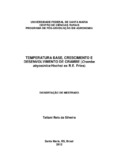| dc.creator | Silveira, Tatiani Reis da | |
| dc.date.accessioned | 2017-05-16 | |
| dc.date.available | 2017-05-16 | |
| dc.date.issued | 2012-02-28 | |
| dc.identifier.citation | SILVEIRA, Tatiani Reis da. Based temperature, growth and development of crambe(Crambe abyssinica Hochst ex RE Fries). 2012. 67 f. Dissertação (Mestrado em Agronomia) - Universidade Federal de Santa Maria, Santa Maria, 2012. | por |
| dc.identifier.uri | http://repositorio.ufsm.br/handle/1/5073 | |
| dc.description.abstract | The crambe is an oilseed that belongs to the Brassicaceae family, is considered a
winter crop, with good tolerance to frost. In the state of Rio Grande do Sul, missing
information on the growth, development and adaptation of crambe, which limits the
adoption by producers of culture. The knowledge of thermal and base temperature
scale allows the crop cycle, helping to define the sowing date and correct timing of
the implementation of management practices. Thus, this study aims to evaluate and
characterize the growth and development of crambe, to determine the thermal over
the cycle and by different methods to estimate the base temperature for the cultivar
Brilliant FMS. An experiment was conducted at the Federal University of Santa Maria,
in the years 2010 and 2011, the following sowing dates: 06/10/2010, 07/05/2010,
08/03/2010, 08/19/2010, 09/09/2010, 09/17/2010, 02/18/2011, 04/06/2011,
04/28/2011, which was evaluated twice a week the phenological stage of the height
and number of leaves of 20 plants each time. Using daily temperature data, we
calculated the basis for the subperiods temperature sowing-emergence, emergence,
flowering, fruiting, flowering, fruit-maturation and maturation-emergency, by
traditional methods: a smaller deviation in degree-days, the lower standard deviation
days, X-intercept, coefficient of variation in degree-day coefficient of variation in days
and the regression coefficient; by methods modified by Yang et al. (1995), which are
offset in degree-days, lower standard deviation in days , coefficient of variation in
degree-days and the regression coefficient, and proposed new methods: pseudopseudo-
sigma and sigma in days. The method estimated more accurately subperiods
higher, with the temperature average basis for emergency subperiod maturation of
4.5 ° C. The increase both in height and in the number of sheets is down to 300 °
days, thereafter the plants grew faster variable up to about 900 ° days, when the
stabilizing time and the number of sheets decreases because of senescence. | eng |
| dc.description.sponsorship | Coordenação de Aperfeiçoamento de Pessoal de Nível Superior | |
| dc.format | application/pdf | por |
| dc.language | por | por |
| dc.publisher | Universidade Federal de Santa Maria | por |
| dc.rights | Acesso Aberto | por |
| dc.subject | Crambe abyssinica | por |
| dc.subject | Temperatura base | por |
| dc.subject | Soma térmica | por |
| dc.subject | Análise de
crescimento | por |
| dc.subject | Crambe abyssinica | eng |
| dc.subject | Base temperature | eng |
| dc.subject | Thermal | eng |
| dc.subject | Growth analysis | eng |
| dc.title | Temperatura base, crescimento, desenvolvimento de crambe (Crambe abyssinica Hochst ex R.E. Fries) | por |
| dc.title.alternative | Based temperature, growth and development of crambe(Crambe abyssinica Hochst ex RE Fries) | eng |
| dc.type | Dissertação | por |
| dc.description.resumo | O crambe é uma oleaginosa que pertence a família das Brassicaceae, é considerada
uma cultura de inverno, com boa tolerância a geadas. No Estado do Rio Grande do
Sul, faltam informações sobre o crescimento, desenvolvimento e adaptação do
crambe, fato que limita a adoção da cultura pelos produtores. O conhecimento da
soma térmica e da temperatura base permite dimensionar o ciclo das culturas,
ajudando na definição da data de semeadura e o momento correto da realização das
práticas de manejo. Sendo assim, o presente trabalho visa avaliar e caracterizar o
crescimento e o desenvolvimento do crambe, determinar a soma térmica durante o
ciclo e estimar através de diferentes métodos a temperatura base para a cultivar
FMS Brilhante. Conduziu-se um experimento na Universidade Federal de Santa
Maria, nos anos de 2010 e 2011, nas seguintes épocas de semeadura: 10/06/2010,
05/07/2010, 03/08/2010, 19/08/2010, 09/09/2010, 17/09/2010, 18/02/2011,
06/04/2011, 28/04/2011, onde avaliou-se duas vezes por semana o estágio
fenológico a altura e o número de folhas de 20 plantas de cada época. Utilizando
dados de temperaturas diários, calculou-se a temperatura base para os subperíodos
semeadura-emergência, emergência-florescimento, florescimento-frutificação,
frutificação-maturação e emergência-maturação, pelos métodos tradicionais: menor
desvio em graus-dia, menor desvio padrão em dia, X-intercepto, coeficiente de
variação em graus-dia, coeficiente de variação em dias e coeficiente de regressão;
por métodos modificados por Yang et al.(1995), que são: desvio em graus-dia,
menor desvio padrão em dia, coeficiente de variação em graus-dia e coeficiente de
regressão; e por novos métodos propostos: pseudo-sigma e pseudo-sigma em dias.
Os método estimaram com maior precisão subperíodos maiores, sendo a
temperatura base média para o subperíodo emergência maturação de 4,5°C. O
crescimento tanto em altura quanto em número de folhas é baixo até os 300°dias, a
partir de então as plantas apresentaram crescimento rápido das variáveis até cerca
dos 900° dias, quando a altura estabiliza e o número de folhas descresce em razão
da senescência. | por |
| dc.contributor.advisor1 | Lopes, Sidinei José | |
| dc.contributor.advisor1Lattes | http://buscatextual.cnpq.br/buscatextual/visualizacv.do?id=K4700757Z3 | por |
| dc.contributor.referee1 | Lúcio, Alessandro Dal col | |
| dc.contributor.referee1Lattes | http://buscatextual.cnpq.br/buscatextual/visualizacv.do?id=K4799931H1 | por |
| dc.contributor.referee2 | Lorentz, Leandro Homrich | |
| dc.contributor.referee2Lattes | http://buscatextual.cnpq.br/buscatextual/visualizacv.do?id=K4700767T6 | por |
| dc.creator.Lattes | http://lattes.cnpq.br/5858799063915614 | por |
| dc.publisher.country | BR | por |
| dc.publisher.department | Agronomia | por |
| dc.publisher.initials | UFSM | por |
| dc.publisher.program | Programa de Pós-Graduação em Agronomia | por |
| dc.subject.cnpq | CNPQ::CIENCIAS AGRARIAS::AGRONOMIA | por |


